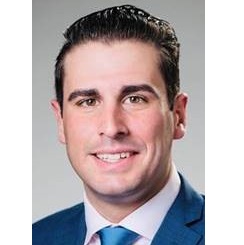Published by Andrew Parr on October 1st, 2020
I played golf throughout college and, one of the things I learned is that you have to approach every tournament round differently. You have to take a big picture approach because you never know what's going to have changed; weather and course conditions are always going to throw something new at you. Because of that, you never play the course or even a hole the same way twice.
Why do I bring up golf? Well, aside from my passion for the game, this big picture mentality, of adapting to differences in conditions is the same way that I approach enrollments and voluntary benefits. No two cases are the same. One shot isn't always going to work on the golf course and one strategy isn't always going to work in the world of voluntary. You can't get too focused on any one strategy. So, on that note, I thought I’d share a few ways I approach things to help take a more strategic, big picture, approach and deliver value for my clients.

Multi-year enrollment planning
Let’s say you’ve got an employer, they’re eager to add voluntary and you’re eager to help them implement their benefits program. All’s well, right? Well, you may be setting yourself up for failure if you’re only looking at this year’s enrollment. What if, instead, you took a bigger picture look?
Sometimes, a long-term approach can be more effective. Rather than planning this year’s enrollment, why not make a plan to implement the voluntary program over say, 2, or even 3 years? Introducing benefits one or two at a time over multiple years has a number of benefits. It allows you time to introduce and educate on each of the benefits more thoroughly, it prevents employees from being overwhelmed and gives them time to re-evaluate their needs between enrollments. Oftentimes, the education and focus on one or two benefits each year means higher enrollment rates and employees making better decisions.
Enrollment communication strategy, not tactics
There are lots of things that can go into an enrollment. What technology are you going to use to enroll? How are you going to communicate to employees about the enrollment? What sorts of support will you provide for employees as they enroll? Will you use an enrollment firm (you should!)?
Don’t treat these decisions as individual choices. These are just tactics, but what you need, is a strategy. With a big picture approach, you can look at ways to tie all these different tools together. With them operating in unison, you can create a consistent pre-enrollment communication message, backed up with technology and resources that reinforce and support that message. The end result is a more coherent, easier to understand enrollment strategy that will drive participation and employee satisfaction.
Don’t lose sight of the employer’s goals
As a voluntary benefits representative, it’s easy to focus on the benefits and, especially the voluntary benefits. But, you have to look at the whole program when working with an employer. While, of course, I’d love it if the emphasis of every case was the implementation of voluntary benefits, that’s not always the way it goes. Take a step back and make sure the solution you’re crafting is truly addressing the employer’s needs; whether that be wellness, HDHP transition or any number of programs and initiatives they want to implement. It may not be the emphasis you were hoping for, but it sets you and your employer up for a long-term successful relationship.
Think about the end before the beginning – measure!
When you’re planning your enrollment, there’s a lot to take into consideration. And, justifiably, it’s easy to put your emphasis on getting things in order to enroll a case. If you really want to plan for success, though, look at the bigger picture and think about how you want to look at the case after it’s done enrolling. What do you want to measure and show to the employer after enrollment? What do you want to learn for yourself about the enrollment? What will help you set up subsequent enrollments for success? Every enrollment is a chance, yes to generate business, but just as importantly it’s a chance to learn and improve. Planning to measure results is a great way to get at those added benefits for yourself and your client.
A successful voluntary benefits program requires a number of pieces working in concert. It’s one of the reasons that having a big picture outlook is so valuable. As the newest member of the Trustmark team, I’m excited to bring this approach to our clients. One of the reasons I was drawn to work at Trustmark is our shared vision for long-term relationships. With the right approach, together, we can all create better outcomes, better relationships and longer lasting success.
Why do I bring up golf? Well, aside from my passion for the game, this big picture mentality, of adapting to differences in conditions is the same way that I approach enrollments and voluntary benefits. No two cases are the same. One shot isn't always going to work on the golf course and one strategy isn't always going to work in the world of voluntary. You can't get too focused on any one strategy. So, on that note, I thought I’d share a few ways I approach things to help take a more strategic, big picture, approach and deliver value for my clients.

Multi-year enrollment planning
Let’s say you’ve got an employer, they’re eager to add voluntary and you’re eager to help them implement their benefits program. All’s well, right? Well, you may be setting yourself up for failure if you’re only looking at this year’s enrollment. What if, instead, you took a bigger picture look?
Sometimes, a long-term approach can be more effective. Rather than planning this year’s enrollment, why not make a plan to implement the voluntary program over say, 2, or even 3 years? Introducing benefits one or two at a time over multiple years has a number of benefits. It allows you time to introduce and educate on each of the benefits more thoroughly, it prevents employees from being overwhelmed and gives them time to re-evaluate their needs between enrollments. Oftentimes, the education and focus on one or two benefits each year means higher enrollment rates and employees making better decisions.
Enrollment communication strategy, not tactics
There are lots of things that can go into an enrollment. What technology are you going to use to enroll? How are you going to communicate to employees about the enrollment? What sorts of support will you provide for employees as they enroll? Will you use an enrollment firm (you should!)?
Don’t treat these decisions as individual choices. These are just tactics, but what you need, is a strategy. With a big picture approach, you can look at ways to tie all these different tools together. With them operating in unison, you can create a consistent pre-enrollment communication message, backed up with technology and resources that reinforce and support that message. The end result is a more coherent, easier to understand enrollment strategy that will drive participation and employee satisfaction.
Don’t lose sight of the employer’s goals
As a voluntary benefits representative, it’s easy to focus on the benefits and, especially the voluntary benefits. But, you have to look at the whole program when working with an employer. While, of course, I’d love it if the emphasis of every case was the implementation of voluntary benefits, that’s not always the way it goes. Take a step back and make sure the solution you’re crafting is truly addressing the employer’s needs; whether that be wellness, HDHP transition or any number of programs and initiatives they want to implement. It may not be the emphasis you were hoping for, but it sets you and your employer up for a long-term successful relationship.
Think about the end before the beginning – measure!
When you’re planning your enrollment, there’s a lot to take into consideration. And, justifiably, it’s easy to put your emphasis on getting things in order to enroll a case. If you really want to plan for success, though, look at the bigger picture and think about how you want to look at the case after it’s done enrolling. What do you want to measure and show to the employer after enrollment? What do you want to learn for yourself about the enrollment? What will help you set up subsequent enrollments for success? Every enrollment is a chance, yes to generate business, but just as importantly it’s a chance to learn and improve. Planning to measure results is a great way to get at those added benefits for yourself and your client.
A successful voluntary benefits program requires a number of pieces working in concert. It’s one of the reasons that having a big picture outlook is so valuable. As the newest member of the Trustmark team, I’m excited to bring this approach to our clients. One of the reasons I was drawn to work at Trustmark is our shared vision for long-term relationships. With the right approach, together, we can all create better outcomes, better relationships and longer lasting success.
Contact Andrew to start working with a representative who will keep the big picture in focus!
